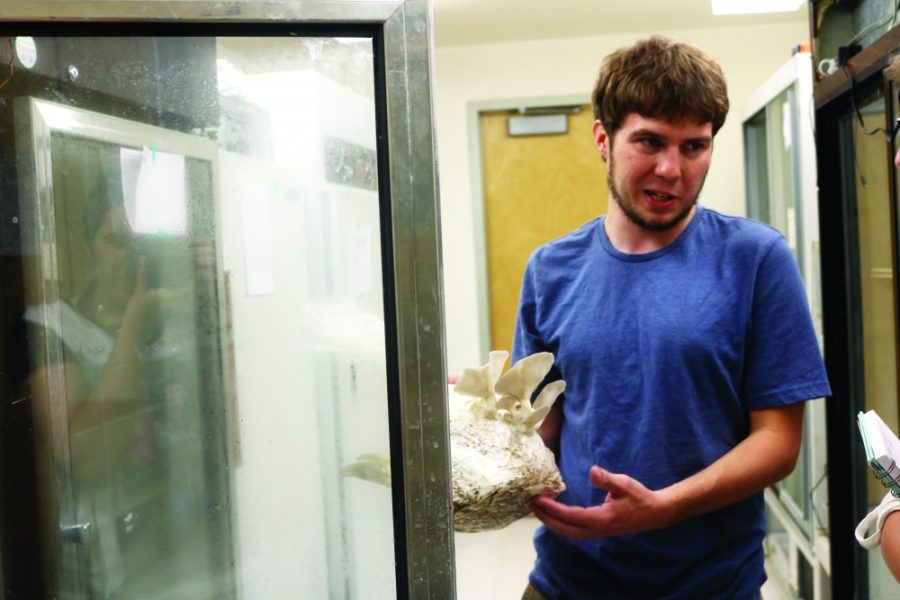Tucked away in a lab on the fifth floor of the Marley building is a world of fungi. It is here that the MycoCats grow mushrooms in mixtures never thought possible. From mesquite bean pods to greasy pizza boxes, the university’s trash is being turned into something gourmet.
The MycoCats program is a student-run organization funded by the UA Green Fund. It is directed by Dr. Barry Pryor, a professor in the UA School of Plant Sciences, and managed by plant pathology graduate student Parker Evans.
Evans first became involved at the Pryor Laboratory after taking Dr. Pryor’s Mushrooms, Molds, and Man class.
The Pryor Laboratory website describes the MycoCats’ research as sustainable cultivation of gourmet mushrooms.
In the lab, the MycoCats create mushroom substrate, or soil, from fallen mesquite bean pods, coffee grounds, invasive buffelgrass, cardboard, paper scraps and greasy pizza boxes.
“We use living organisms to recycle agricultural and post-consumer waste,” Evans said.
One sustainable substrate, which has been successful in growing mushrooms, has been the mesquite bean pod. Often used to make flour, mesquite bean pods are usually rendered inedible once they fall to the ground. This is because fallen pods sometimes develop a fungus called Aspergillus, which produces aflatoxin, a carcinogen, according to Evans.
Although harmful to humans, these bean pods provide a perfect growing medium for mushrooms. The mushrooms are able to break down the toxin and use the bean pods as a food source.
Used, greasy pizza boxes also make for an excellent mushroom substrate. The grease from the pizza provides an additional food source for the mushrooms.
“There’s a number of good programs out there if you have a non-greasy piece of cardboard; it will recycle perfectly. But there are these little niche applications, which fungi are exceptional at completing,” Evans said.
In order to grow the mushrooms, the MycoCats start out by growing the mushroom cultures on a petri dish to produce mycelia, the branching part of the fungi from which the mushrooms grow. MycoCats then mix the mycelia with barley and let the mixture sit for one week.
After a week, they add the recyclable materials, like the ground-up mesquite bean pods, to the barley and let the mixture sit for another two weeks.
When the material in the bags has turned white, they poke holes into the bags and transfer them to humidity-controlled refrigerators. There, mushrooms grow out of the holes.
Right now, according to Evans, they are growing six different species of mushrooms, including a warm weather shitake variety. The mushrooms that are grown by the MycoCats are distributed to commercial growers in Tucson and Phoenix.
The MycoCats are also involved in extension outreach work through the College of Agriculture and Life Sciences.
At Tucson Village Farm, an urban farm housed at the UA Pima County Cooperative Extension office, mushrooms are grown in a solar-powered, swamp-cooled shed. The mushroom shed was created as a part of Dr. Pryor’s son’s Eagle Scout project.
The mushrooms grown at Tucson Village Farm are sold at the farm’s weekly U-Pick events.
“People love them,” said Elizabeth Sparks, the 4-H youth development assistant agent for Tucson Village Farm. “The ones in the stores don’t even look beautiful because they have come such a long distance, and here they are beautiful and delicious.”
The MycoCats are exceeding the boundaries of traditional mycology, finding innovative ways to complete the cycle of sustainability. With new discoveries popping up every day, Evans says to look out for more advances in a variety of fields, from mushrooms that can eat plastic, to mushrooms that can be used as pharmaceuticals.
After all, mushrooms are more closely related to us than they are to plants, providing a unique opportunity for further research.
Follow Natalie Robbins on Twitter.









